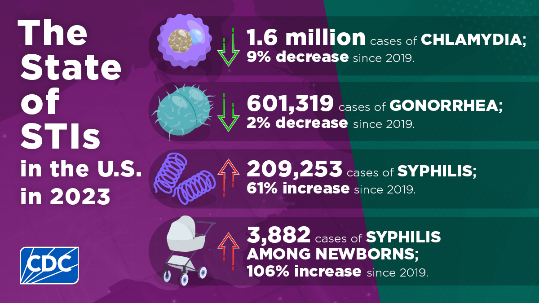
Data & Statistics
Sexually Transmitted Diseases (STDs) continue to rise in the United States, and trends throughout the southeastern states resemble those of the nation. One in two sexually active persons will contract an STD by age 25 (Cates et al., 2004). The Centers for Disease Control and Prevention (CDC) estimates that nearly 20 million new STIs occur annually in this country, half of those among young people aged 15–24 (CDC, 2015). Click the link below for more information about the latest CDC 2023 Surveillance Report. The data presented here provides additional details about STDs in Georgia.
State of STDs in Georgia: Preventing Sexually Transmitted Diseases (2023)
2023 CDC Sexually Transmitted Disease Surveillance Report
The CDC has published its 2023 Sexually Transmitted Disease (STD) Surveillance Annual Report, highlighting trends in reportable infections and stressing the continued need to address STDs as a public health priority. The report shows that more than 2.4 million STIs were reported in the United States in 2023. While gonorrhea dropped 7% and primary/secondary syphilis cases declined 10% since 2022, congenital syphilis rose 3%, though at a slower rate than previous years. Despite these improvements, STIs remain unacceptably high, requiring continued national efforts to address disparities and control their spread.
Click here to access the full CDC Sexually Transmitted Disease Surveillance Report.
Looking for More Georgia STD Data? Online Analytical Statistical Information System (OASIS)
Obtain tables, maps, and charts of various public health indicators. Vital statistics (births, deaths, fetal deaths, induced terminations), hospital discharge, emergency room visits, STD, motor vehicle crashes, and population data are included. All data can be selected by age, race, sex (Person), state, county, census tract/ county commission district/ Demographic Cluster available (Place), and year (Time).
Click here for more OASIS Data & Statistics

Additional Data Resources:
The CDC has released the 2023 STD and Congenital Syphilis (CS) data, now accessible via AtlasPlus, a powerful tool offering nearly 20 years of surveillance data. Users can explore STD trends, generate customized visualizations, and analyze data alongside social determinants of health (SDOH) to uncover disparities and inform targeted interventions.
Learn more and access the data at CDC AtlasPlus Tool
Looking for Additional CDC Data? CDC Data & Statistics
Page Last Updated 11/25/2024